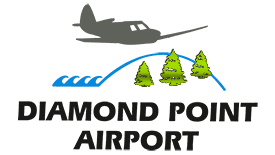Diamond Point Airport – 2WA1
Procedures Briefing
Welcome to Diamond Point! The Associate or Regular Member of the Diamond Point Airport Association in good standing that has sponsored your visit wishes you to become familiar with our airport and the particular challenges it can present. Please review the following considerations before your flight and landing.
You Must fill Out and Submit the Arrival PPR (Prior Permission Required form ) prior to arrival.
The runway is 11/29, and is 2335′ x 24′, asphalt in good condition. All patterns are flown over the water to the north of the field; left traffic for runway 11, and right traffic for 29. The airport is situated on a bluff, at 262′ elevation, and the drop-offs at either end can generate severe up or downdrafts and turbulence. There is NO OVERRUN at either end. Runway 29 has a 200′ displaced threshold and runway 11 a 100′ one. The displaced thresholds are necessitated by a power line on the east end with Red Avoidance Lighting, and trees on the west end. Winds can be both changeable and strong, especially in the afternoons. To land comfortably you should feel confident that you can land your plane in 1000-1200’.
Our CTAF frequency is 122.9. Even when there is no traffic present, please announce your presence and intent, as someone is nearly always monitoring the frequency. We encourage you to overfly the field to familiarize yourself with the runway environment before landing. The official windsock is past midfield toward the west, on the south side. In addition, there are other windsocks visible from the eastern approach path.
Plan to land past the displaced threshold lines, with a steeper approach that keeps you above the terrain-generated disturbances. Flying a stabilized approach that puts you at 700-800′ MSL when turning final will help guarantee a proper glideslope. Also be aware of possible descent path illusion: the narrow runway sitting on a bluff may make it appear that you are too high, and that the runway is longer than it is. Maintain your descent angle while taking in the entire runway environment.
We have a large and fearless resident deer population. Overflight of the runway environment will enable a windsock check as well as a check for deer on or near the runway.
Transient parking is just east of the shed on the south side of the runway, accessed via taxiways A2 or A3 to Alpha. If you are parking as the guest of someone on their property, make sure you have instructions on how to get there. Stop before crossing any street or road. When taxiing on the east end of Alpha, be certain to stay in the center of the flat surface, as the ground falls away on the north side.
As a courtesy to our neighbors, upon departure from runway 11, delay turnout until over the water. Upon departure from runway 29, follow the drainage channel to the northwest, avoiding overflight of the homes west of the drainage.
If you have questions or difficulties, check on our frequency for someone to advise. If you are unable to land because of weather or other issues, Jefferson County International (0S9 123.00) is about five miles to the east, with significantly different weather, a large runway, and facilities.
Be well aware that ALL operations on airport property are at the sole risk of the pilot. This includes taxiing, parking, and landing on or departing from any surface.
Please be careful, considerate, and safe!
Thank you from the members of the Diamond Point Airport Association.

